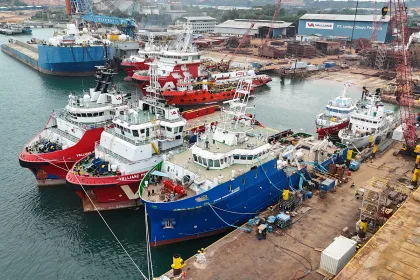We shine a light on the tourism sector in Asia Pacific following the pandemic, the recalibration of the travel market and the potential for digitalisation expected to drive economic recovery.
Worldwide, one in every ten jobs results from tourism.
A global health, economic and social emergency of unprecedented magnitude, the coronavirus pandemic triggered a standstill of international travel. What originated in Wuhan of December 2019 had bought the tourism sector to its knees by April 2020, as visitor numbers dropped off the graph in a shocking decline. Nowhere was this more evident than across Asia Pacific as the region that was hit first, and arguably, the hardest.
A sector that is integral to the global economy, tourism accounts for 10 percent of gross domestic product. Yet over the course of 2020, the industry lost an estimated $1.3 trillion in export revenue, as countries worldwide recorded an overall decline of 35 to 48 percent in tourism expenditure. International arrivals dropped by an unprecedented 74 percent, as reported by the World Tourism Organisation.
As the crux of worldwide international travel and the region where the pandemic found its source, Asia Pacific suffered an 84 percent slump in overseas visitors and recorded the greatest decrease in tourist numbers at 300 million. Countries including China, Japan, Korea, Hong Kong SAR, Taiwan, Thailand, Vietnam, Cambodia, and Myanmar, handled the initial wave of infections well and embarked on relaxing restrictions as the number of new cases began to trickle out. However, plans for tourism recovery were soon thwarted by the second wave of infections that arrived in late July and August.
Not only does this region boast some of the world’s most iconic tourist destinations – the Taj Mahal, Angkor Wat, and the Great Wall to name but a few – we must also consider that Asia Pacific is the largest tourism-generating area in the world. As the principal source nations for the tourism sector, international travel is heavily reliant on departures from China and Hong Kong SAR.
In Vietnam for instance, around 80 percent of the country’s foreign tourism spending are from international tourists across Asia. In Thailand, the leader of tourism in South East Asia, the nation is essentially dependent on Chinese tourists. Indeed, across the Asia Pacific region in 2018, Chinese tourists represented 60 million tourist arrivals.
As such, tourism industry players must diversify their outreach to extend beyond the traditional demographic of overseas visitors, as in 2019 when domestic tourist expenditure across Asia Pacific was at an all-time high. Through exploiting the possibilities of regional travel, travel industry players can recalibrate the travel market to redress the balance away from China.
Partnerships between the government and destination management organisations (DMOs) play a big part in this, as seen with the Thai government’s programme, ‘We Travel Together’, launched back in July 2020, which allowed Thai tourists to pay 60 percent of hotel room rates while the government subsidises the rest, along with 40 percent of the cost of an airline ticket.
Returning to the example of Vietnam, internal travel has been a lifesaver for the industry, as it was reintroduced in time for last year’s summer season following a ten-month international border closure. Alongside China, this has been one of the few Asian countries that has been relatively mildly impacted by the pandemic and did not fall into a recession during 2020. At a contrast to this, the pandemic has been ruinous for Sri Lanka’s economy exposing its vulnerability and impeding essentially all economic activity, which contributed to a hastened reopening of the borders in January 2021 and a pioneering ‘biosafety’ bubble programme implemented by the Sri Lanka Tourism Development Authority (SLTDA).
Countries across the continent must consolidate and work together to accelerate tourism recovery using the formation of travel corridors and bubbles to enhance intra-regional travel whilst attitudes remain hesitant towards long-haul destinations and inter-continental travel. Vaccine passes may also act as a catalyst.
The detrimental effect of the pandemic on the tourism sector is yet to be fully realised, but economically speaking, it cannot be undermined. The World Bank have estimated that at least 11 million more people across East Asia and Pacific could fall into poverty in the wake of the virus.
This vast region comprises a host of nations where tourism is the lifeblood of the economy – whether established or developing. Vietnam, Indonesia, Malaysia, Singapore and the Philippines have all demonstrated significant GDP growth resulting from tourism, whilst elsewhere, it is an essential component to stimulate emerging economies.
The industry is also vital as a core provider of employment opportunities. According to WTC, of the 50 million tourism jobs that are likely to be lost due to the pandemic, 30 million of these job losses would be across Asia Pacific.
On every level of the tourism value chain – from DMOs to transport providers and hotels – resilience will continue to be tested over the next few years. This will essentially restructure the sector, as large international operators stand the greatest chance of adaptation and survival. Countries that boast a sector infrastructure with robust vertically integrated supply chains and local production capacities are expected to rebound fastest.
The outlook of the industry in general forecasts a cautious return to pre-pandemic levels of travel by 2023, according to a survey conducted by UNWTO’s panel of tourism experts.
Post-pandemic recovery is largely dependent on the actions of established industry players and national governments to maintain the sector’s survival. A variety of short-term solutions can be leveraged to mitigate the virus’ impact, including effective marketing strategies to encourage traveller confidence and keep audiences informed with regards to recovery progress. Alongside this, airlines such as Vietnam Airlines are boosting their offering of low-cost fares to stimulate interest, although such measures are unsustainable in the long term.
Long term recovery will necessitate significant investments in infrastructure not only within transport, to improve geographical connectedness across the region outside of air travel, but crucially within healthcare and digital developments as well.
Arguably the most effective in terms of fiscal aid, is the degree to which national governments are committed to the sector’s revival. Singapore is a notable example of the contingency of government involvement on the sustenance of tourism, as the nation was ranked sixth globally in the Travel and Tourism Competitiveness Report published by WeForum in 2019 due to government prioritisation, spending on travel and tourism, and effectiveness in marketing.
Aside from finance, local governments can implement measures such as easier visa attainment, in a bid to boost tourist numbers moving forward. Governments will be expected to adopt a proactive role, as seen in Sri Lanka where the industry anticipates the introduction of government-led concession relief packages, the reduction of tax burdens and the implementation of policies to rebuild the sector as part of the country’s Tourism Resilience Plan. The Asian Development Bank continue to contribute support payments to aid governments across the region, financing policy measures.
Sponsorships within the private sector should be capitalised to optimise exposure for smaller enterprises, taking advantage of well-integrated supply chains and benefitting from the wider footprint of larger organisations. Inter-sector partnerships are also an avenue worthy of exploration, including between hotel operators and health insurance providers, whereby travellers can access comprehensive health insurance through booking directly with the hotel.
Incorporating flexibility will be essential, particularly with regards to hotels, as seen with the Tauzia Hotel Group in Indonesia who have launched a ‘Pay Now, Stay Later’ option. Of course, this is easier for larger hotel chains and international operators that cover a range of middle-income countries.
The most promising aspect is the untapped potential of Smart Tourism in reshaping the sector – an essential component to post-pandemic recovery. Digital applications can be used to implement COVID-19 risk reduction measures such as tracing, digital vaccination certificates and real-time mobile alerts for traveller’s whilst in country. For instance, in Singapore, the ‘TraceTogether’ contact tracing app is mandatory for overseas visitors and works through emitting Bluetooth signals if you have been within close contact of the virus.
Digitisation should be leveraged to inspire the confidence of tourists and streamline travel arrangements. This will play a key role in the initial destination selection process now that safety has become a paramount concern for travellers worldwide. Software giant Adobe is partnering with leading brands throughout the industry, launching data-driven initiatives designed to transform the personalised traveller experience.
Essentially, this also plays a large role in the ‘contactless’ travel experience, taking advantage of keyless hotel entry, check-ins through mobile applications and other distancing measures, as seen with Beijing Capital International Airport where the passenger’s entire journey has become automated using biometric technologies including facial recognition systems.
By restructuring the sector with data-driven results and harnessing the potential of digital innovation with a core emphasis on sustainability, we ameliorate the chances for recovery. Across Asia Pacific, the playing field is far from level and the tourism challenge varies depending on the country. However, what is clear is that economic recovery rests on the restoration of tourism and requires a significant collective effort. Over the course of the next few years, Asia Pacific’s mode of recovery will likely set the precedent that the rest of the world will follow.





































